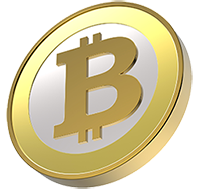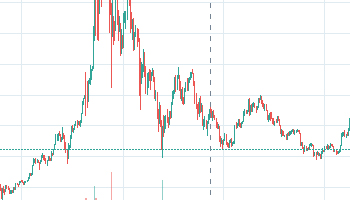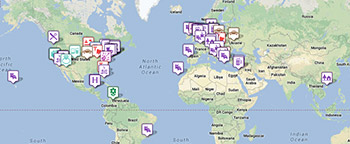A well-diversified portfolio uses the concept of buckets. Each type of investment or asset class goes into a separate bucket. The idea is to avoid putting too much money into any one thing and getting wiped out. In this article, we’ll use the bucket concept to make it clear how trading or investing in bitcoin fits into a well-diversified portfolio.
Let’s now look at how a Bitcoin investor can have their cake and eat it too.
Bitcoin – Committed or a Dabbler?
With Bitcoin (and cryptocurrencies) you’re either truly committed or you’re more of a dabbler. You know which one you are. For the truly committed, investments in Bitcoin often reach 60 percent or more of total investable assets. You’re all in. Your fortune rises and falls with the live price. Living with the frequent fluctuations in price doesn’t make you sweat. Volatility is nothing to worry about. This is your mantra.
With the dabbler, it’s more of a 5-20% allocation to the cryptocurrency asset class - and Bitcoin specifically. The price fluctuations make you nervous. You don’t like to admit it, but they do. You need a strategy that enhances your comfort zone, so you can invest in crypto without being overly concerned.
This article mostly addresses the dabbler. You want to have a balance of different investments within a well-diversified portfolio. That way, there’s no losing sleep over the fluctuations in the price of Bitcoin. You can ride them up and down without concern about risk tolerance. You only buy as much as you’re comfortable with. It also avoids selling after a fall in the price and locking in that loss permanently too.
The Bitcoin& Dry Powder Buckets
There are almost as many trading strategies for Bitcoin as there are buyers and sellers at this point. Whether using momentum as an indicator, buying on the dips, or using another trading strategy, it’s best to fix on a single approach that you’re comfortable with and stick with it. Coping with the whipsaws in price is easier when you have a plan and you’re just working that plan.
Dry powder is a term used to mean cash you set aside for golden investing opportunities. This is when Bitcoin has gone below your trigger price and you want to buy more. If you’re already fully invested with the portfolio’s allocation to Bitcoin, then there’s just the dry powder bucket to dip into to find the extra funds. When opportunity knocks in the form of cheaper prices, back up the truck. That’s what the dry powder bucket is there for.
The Diversified Bucket
You must decide what type of investor you wish to be. You can be a total market investor, a growth investor or a value investor.
A total market investor only wants to own everything with no slant towards faster-growing or cheaper companies. A growth investor prefers fast-growing companies often even if they’re overpriced compared to the current or historical market valuation, e.g. Apple, Google, etc. A value investor focuses on paying 50 cents or less for a company worth a dollar per share and then waits for the underpricing to correct itself; they may sell at that point to find another value opportunity or hold for the long-term.
Investment Strategy for the Diversified Bucket
The diversified bucket is intended to provide a well-rounded portfolio. There are different ways to put together a collection of diversified holdings.
The first way is to research and select a collection of stocks. This active investing requires being able to understand the fundamentals of each business, researching the company and the sector of the economy that it operates within. Looking at valuation metrics to determine whether the company is cheap relative to the market or not.
The second way is to research and pick some mutual funds or ETFs. Essentially, you’re choosing between investment managers rather than individual companies. It’s a form of active investing where you’re hoping that through the selection of quality investment managers, your diversified holdings will outperform the market, net of fees and taxes.
The third way is to purchase one or more index funds or index ETFs. You’re buying the total market in a single investment or part of it, e.g. a US REIT index fund of all the major real estate investment trusts listed on US stock markets. You’re not trying to beat the market; only match all or part of it. You don’t wish to take the risk of picking poorly when it comes to company or fund managers. Or, you don’t believe a manager can beat the stock market consistently and you don’t wish to try.
The Adventurous Bucket
With the adventurous bucket, you’re free to speculate on stock picks, interesting ideas for new investments, and follow recommendations about certain companies. You’re looking for the ten-bagger (multiplying your investment by 10 times). You’re hoping that the recommendations will pay off, but you’re only risking a modest percent of your total portfolio on these picks. If you get wiped out because the value of the investment goes to zero, it won’t be a total disaster.
The Tom Gentile money call is one such service that provides investing ideas based on a detailed analysis of the 200 most liquid companies in major stock markets. When you’re wanting out-of-the-box thinking, clever ideas you hadn’t thought of, and quick wins, then the weekly money call is worth your time.
The Boring Bucket
The boring bucket is filled with your cash and bond investments. These are your money market, CDs,and balances in your checking accounts along with fixed-income investments. On the fixed income side, make sure they’re bond index funds, as being actively managed in bonds is usually a waste of time. Bonds are too highly traded and well-researched to get an edge there.
When you’ve organized what you’re doing with each bucket, then you’re all set with your diversified portfolio. Free to experiment with Bitcoin trading and edgy, outlandish stock picks without risking your retirement plan into the bargain.


 Updated every 10 minutes
Updated every 10 minutes


